The Gua Sha
The gua sha is made with moss agate; ethically sourced in
Indonesia by an artisanal miner and extracted with hand tools in the
crevices of volcanic formations. Our custom-designed gua sha board is
then crafted in small batches by our artisan in the same locality.
The Shape.

The Stone.
A stone of renewal, trust and hope, moss agate carries within it a deep connection to nature, helping us release stress and expand personal space. It assists us in developing certainty of communication, giving clarity through balance of intuition and intellect. Physically and emotionally, moss agate helps one gain peace and stability, encouraging digestion, neuronal activity, circulation, and the function of the visceral organs into harmony and balance. Placed in contact with skin, moss agate expedites tissue recovery, and it is believed to aid the flow of the lymphatic system, making it an ideal stone for the ritual of gua sha.
The diverse colors and opacity levels shift within this mineral, making each board a unique work of art.
Our gua sha is made with moss agate that is ethically sourced in Indonesia by an artisanal miner and extracted with hand tools in the crevices of volcanic formations. Our custom-designed gua sha board is then crafted in small batches by our artisan in the same locality.
Origins of Gua Sha
Historically, the practice of scraping tools on the skin to relieve dis-ease dates back as far as the Paleolithic era. In terms of major medical records, gua sha treatments were regularly recorded during the Ming Dynasty (1368-1644) in China, where it was used as part of Traditional Chinese Medicine (TCM) to increase blood and lymphatic circulation, effectively reducing muscle tension and aiding the body in expelling toxins.
In Chinese, the term “Gua” means “to scrape” and Sha means “sand”, referring to the spotty, red, sand-like appearance that would arise on skin when performing the practice. The color of the sha is both diagnostic and prognostic. Light-colored sha indicates there is a blood deficiency. If the sha is purple or black, there is long-standing blood stagnation. Dark red sha can also indicate heat.
In modern medical terms, these fluids contain metabolic waste that has become congested in the skin surface tissues and muscles. When more blood and oxygen flow to the area that is treated, the body responds more efficiently and healing can take place.
Benefits of Gua Sha
-
Enhances circulation and collagen production
-
Softens fine lines and wrinkles
-
Decreases puffiness, dark circles, and inflammation
- Naturally lifts and contours, sculpting facial muscles and temporarily tightening skin
-
Reduces hyperpigmentation, as well as lightens old scars.
-
Relaxes and soothes muscle tension and aches.
-
Can be used to treat and prevent the common cold, flu, bronchitis, asthma, as well as any chronic pain disorder or blood/lymphatic congestion.
-
Because it may decrease inflammation on the skin, it is frequently used to treat chronic muscle and joint pains, like those found in arthritis and fibromyalgia.
-
Offers some relief from migraines, shoulder, back, and neck pain, menstrual disorders, insomnia, hypertension, fluid retention, vertigo, sciatica, and much more.
There are two methods of gua sha:
-
Tonifying therapy, which involves slow, moderate scraping that does not draw out sha each time.
-
Purging therapy, which involves heavy, fast rubbing and scraping to bring out as much sha as possible. This is the most common method and can be used to treat common ailments such as fever, influenza and apoplectic sequelae. With purging therapy, the redness should fade in two to four days. Slower fading indicates poor blood circulation.
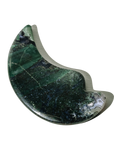
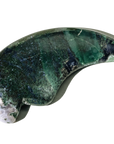
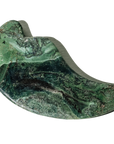
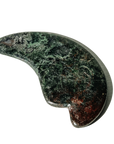

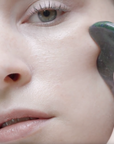
Painterly patterns of stone recall surreal landscapes of water, forest, and lava. This unusual Gua Sha can be applied to the face, scalp, neck, chest and arms. Each piece is one-of-a-kind.
The practice of using gua sha increases blood flow to the treated area, aids lymphatic circulation to remove toxins, and can be used to relax muscle tension. The pointed end of the tool can also be applied in reflexology and acupressure methods.
*Please note that the images shown are a selection only, shown to give a reference of the variation in this natural material. Each tool is visually unique and may not correspond with the images shown.







